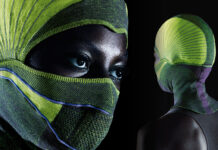Celebrating the need for knitwear designers to be both fashion and textile creators, Fashion Knitwear Design encourages the understanding of the technicalities of knitting by offering a thorough overview of the complexities and heritage of knitwear design. Emphasising the potential held within the unique characteristics of the knitting process, Fashion Knitwear Design is a valuable source of support for students and graduates venturing into industry.
Beginning by presenting the history of knitwear manufacturing, from the first knitting frames in 1589, the invention of the latch needle, and the invention of flat bed machines in1863, a technical scene is set. Yet the spirit of this historic overview reminds new designers that although the knitting industry is one steeped in tradition, it has always been an industry in flux, and the role of a designer is to engineer positive change. Understanding the history of the knitwear industry is presented here as a catalyst for change.
Built around a series of industry case studies, each of the chapters focuses on a fundamental part of the design process. In this way, Fashion Knitwear Design provides a detailed, industry led insight into what new designers can be challenged by, and how they can utilise their transferable design skills.
As students, project briefs are often presented in an educational manner. Fashion Knitwear Design bridges the gap between university and industry briefs by explaining approaches to working on projects. The chapter Research Methods presents examples of how commercial, freelance and personal briefs may differ, and emphasises the importance of thorough, stimulating market led research.
The Yarns chapter was particularly interesting. Designers looking to take a more circular, sustainable approach to projects by educating themselves about the yarn industry would be advantaged by studying this chapter. Designers are often more focussed on aesthetics than the potential yarn choice can hold in influencing the outcome of a design, both visually and technically. Kandy Diamond writes this chapter with a focus on the possibilities held within understanding ones fibre choices by detailing fibre characteristics and spinning methods. Yarn Counts can confuse new designers, but this chapter goes on to explain them clearly. For students and new designers with little manufacturing knowledge, this chapter is a must read.
Until becoming a part of the knitwear industry, understanding the many roles and opportunities within it can be challenging for students and new designers. Fashion Knitwear Design breaks down some of these roles within its Careers chapter by interviewing designers and academics currently working in a variety of industry contexts. The generosity of these designers in sharing their knowledge and career paths provides a motivating insight into the many options for designers starting out in the knitwear industry.
Fashion Knitwear Design is a handbook for new designers looking to understand the industry into which they are entering. Student briefs and internships do not always offer the chance to understand industry language, concepts and expectations. By reading this book, new designers can build their understanding of industry practice and the global market, whilst being motivated to use their unique design skills as a catalyst for change within the industry.
Further information
Edited by Amy Twigger Holroyd & Helen Hill
Hard back
160 pages
Published by The Crowood Press
RRP £25.00

Subscribe To Our Newsletter
Join our mailing list to receive the latest news and updates from our team.






